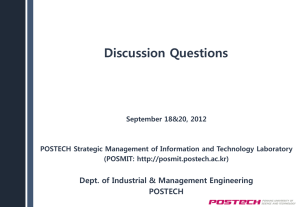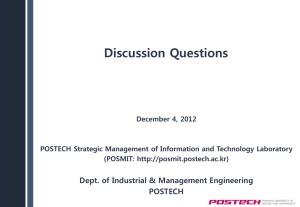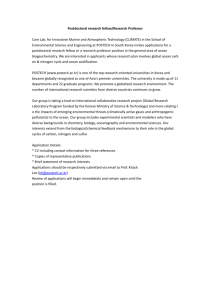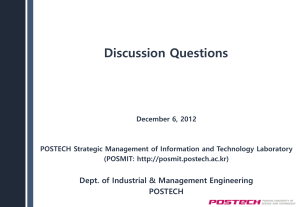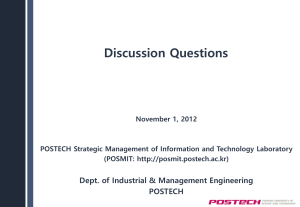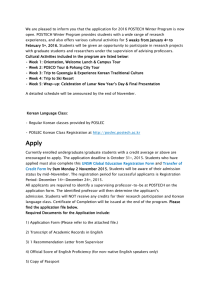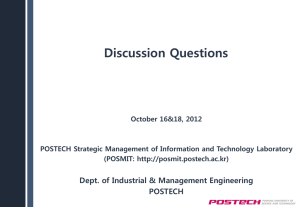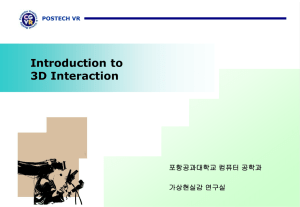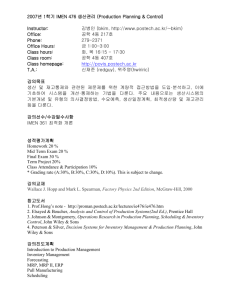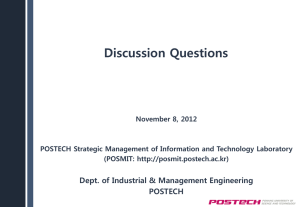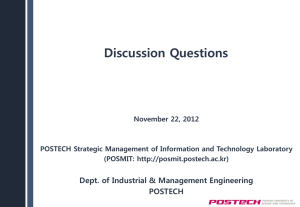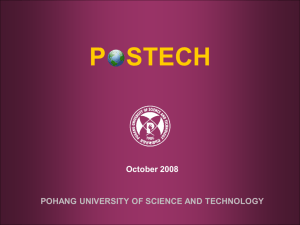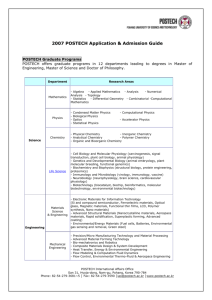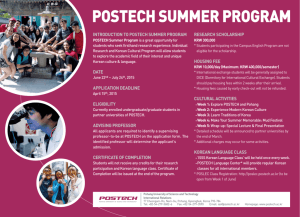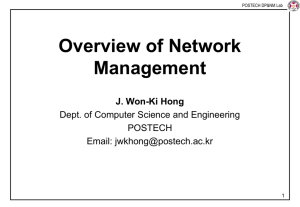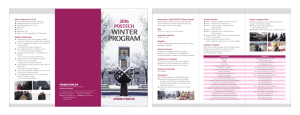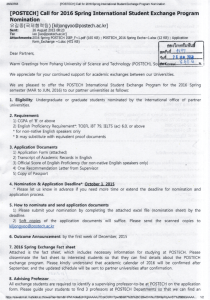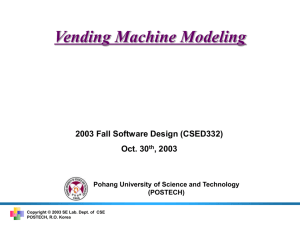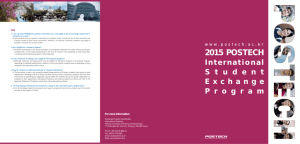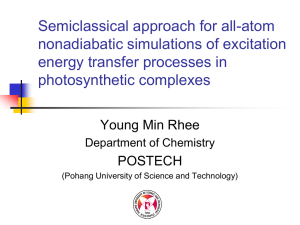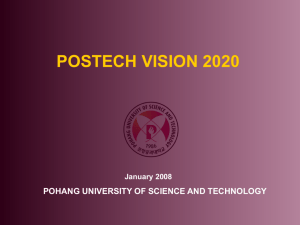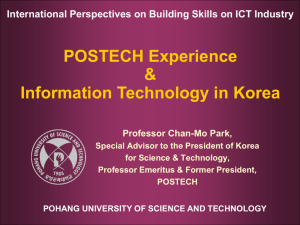POSTECH At A Glance - Times Higher Education
advertisement
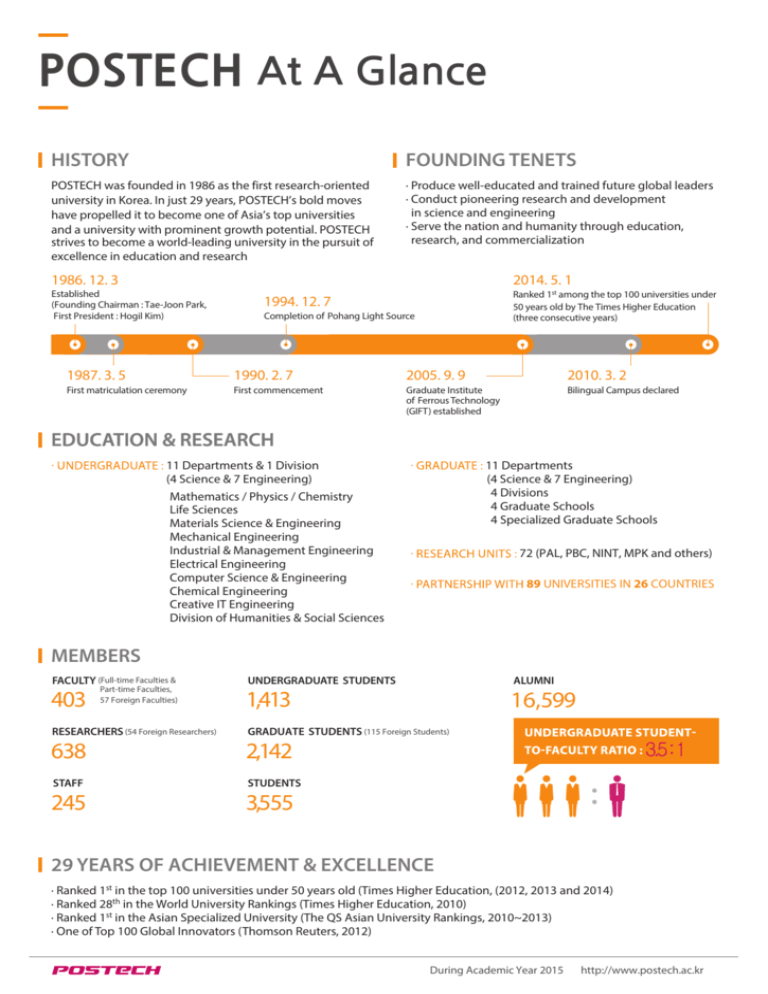
POSTECH At A Glance HISTORY FOUNDING TENETS POSTECH was founded in 1986 as the first research-oriented university in Korea. In just 29 years, POSTECH’s bold moves have propelled it to become one of Asia’s top universities and a university with prominent growth potential. POSTECH strives to become a world-leading university in the pursuit of excellence in education and research · Produce well-educated and trained future global leaders · Conduct pioneering research and development in science and engineering · Serve the nation and humanity through education, research, and commercialization 1986. 12. 3 2014. 5. 1 Established (Founding Chairman : Tae-Joon Park, First President : Hogil Kim) Ranked 1st among the top 100 universities under 50 years old by The Times Higher Education (three consecutive years) 1994. 12. 7 Completion of Pohang Light Source 1987. 3. 5 1990. 2. 7 2005. 9. 9 2010. 3. 2 First matriculation ceremony First commencement Graduate Institute of Ferrous Technology (GIFT) established Bilingual Campus declared EDUCATION & RESEARCH 11 Departments & 1 Division (4 Science & 7 Engineering) Mathematics / Physics / Chemistry Life Sciences Materials Science & Engineering Mechanical Engineering Industrial & Management Engineering Electrical Engineering Computer Science & Engineering Chemical Engineering Creative IT Engineering Division of Humanities & Social Sciences 11 Departments (4 Science & 7 Engineering) 4 Divisions 4 Graduate Schools 4 Specialized Graduate Schools 72 (PAL, PBC, NINT, MPK and others) 89 UNIVERSITIES IN 26 COUNTRIES MEMBERS FACULTY (Full-time Faculties & 403 Part-time Faculties, 57 Foreign Faculties) RESEARCHERS (54 Foreign Researchers) UNDERGRADUATE STUDENTS 1,413 16,599 GRADUATE STUDENTS (115 Foreign Students) 638 2,142 STAFF STUDENTS 245 ALUMNI : 3.5:1 3,555 29 YEARS OF ACHIEVEMENT & EXCELLENCE · Ranked 1st in the top 100 universities under 50 years old (Times Higher Education, (2012, 2013 and 2014) · Ranked 28th in the World University Rankings (Times Higher Education, 2010) · Ranked 1st in the Asian Specialized University (The QS Asian University Rankings, 2010~2013) · One of Top 100 Global Innovators (Thomson Reuters, 2012) During Academic Year 2015 http://www.postech.ac.kr RESEARCH INSTITUTES POHANG ACCELERATOR LABORATORY THE INSTITUTE FOR BASIC SCIENCE (IBS) Pohang Light Source (PLS-II) · The 3rd generation light source at POSTECH · A national research facility used in various basic science to high-tech industrial research · The 5th in the world and the only synchrotron radiation accelerator in Korea · 170 Members (93 Researchers, 60 Technicians, 17 Administrative Staff) · Budget US $ 29.7M (FY 2015) Operating 4 IBS research centers, the most designated to a single institution so far (out of 20 in total) · Center for Self-assembly and Complexity (Director : Prof. Kimoon Kim) · Center for Geometry and Physics (Director : Prof. Yong-Geun Oh) · Academy of Immunology and Microbiology (Director : Prof. Charles Surh) · Center for Artificial Low Dimensional Materials (Director : Prof. Han Woong Yeom) 4th Generation Light Source (PAL-XFEL) · 10 billion times brighter than the 3rd generation light source · Pioneer research in medicine, pharmaceutics, chemistry, material science, nanotechnology, power engineering, and electronics · Scheduled to be operational in 2016 · US $ 365.4M (Total cost for construction) NATIONAL INSTITUTE FOR NANOMATERIALS TECHNOLOGY · A core research center for the advancement and commercialization of nanotechnology · Cutting-edge facilities provide valuable technical support and assistance to industry, from research and development to commercialization POSTECH BIOTECH CENTER · Founded in 2000 with the goal of becoming the hub of biotechnology research and business development (R&BD) · The goal of the center is to incubate disruptive technologies in biotechnology areas for the development of immunology, pharmaceuticals, and nanobiotechnology MAX PLANCK POSTECH/ KOREA RESEARCH INITIATIVE · The Max Planck-POSTECH Center for Attosecond Science and the Max Planck-POSTECH Center for Complex Phase Materials is a testament to POSTECH's internationally renowned research excellence · The collaboration lays the foundation for further strengthening Korea's competitiveness in basic science research C5 (CREATIVE・COLLABORATIVE・ CULTIVATING・CONVERGENCE・CENTER) · C5 plays a pivotal role in catalyzing world-first convergence education and research, and fostering future global leaders with a creative and challenging spirit · C5 is filled by the Dept. of Creative IT Engineering (CiTE), the POSTECH Future IT Innovation Laboratory (i-Lab), POSTECH research teams, and the POSCO Pohang Center for Creative Economy. Its modern open-space design allows them to rearrange work areas freely to facilitate and promote dynamic collaboration ANNUAL BUDGET (FY 2015, US $1= KRW 1,105) REVENUE US $ 277.5M EXPENSES Research Grants & Contracts US $141.9M (51.1%) Endowment Income US $54.1M (19.5%) Tuitions US $ 22.7M (8.2%) Gifts & Special Grants US $14.9M (5.4%) Others US $ 43.9M (15.8%) US $ 277.5M Research Expenses US $137.3M (49.4%) Salaries & Wages US $50.7M (18.3%) Fixed Asset Costs US $15.0M (5.4%) Operation and Maintenance US $ 23.4M (8.4%) Student Aids & Services US $17.9M (6.5%) Others US $ 33.2M (12.0%) ANNUAL TUITION FEE Undergraduate US $5,049 Graduate US $7,833 During Academic Year 2015 http://www.postech.ac.kr
